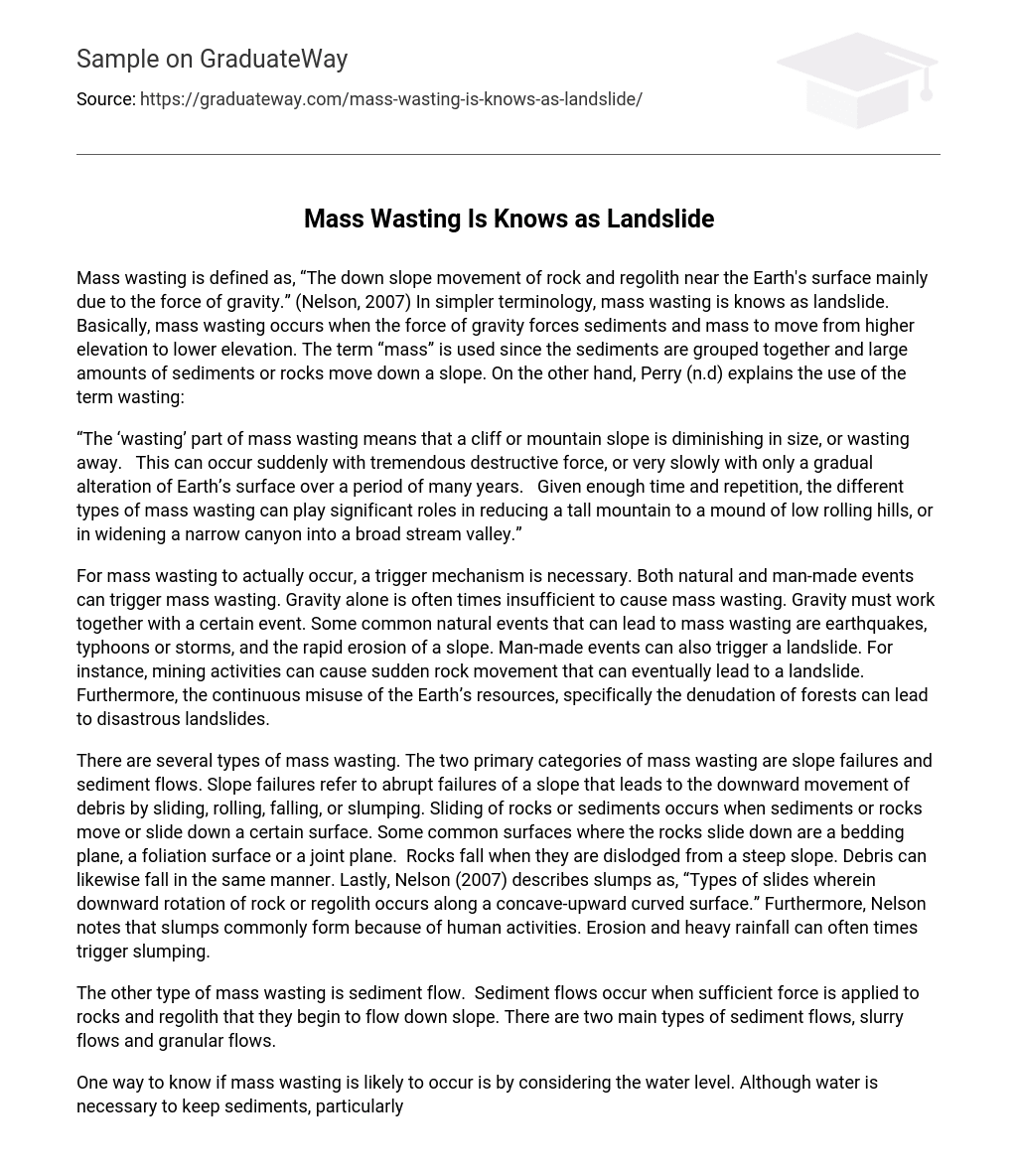Mass wasting is defined as, “The down slope movement of rock and regolith near the Earth’s surface mainly due to the force of gravity.” (Nelson, 2007) In simpler terminology, mass wasting is knows as landslide. Basically, mass wasting occurs when the force of gravity forces sediments and mass to move from higher elevation to lower elevation. The term “mass” is used since the sediments are grouped together and large amounts of sediments or rocks move down a slope. On the other hand, Perry (n.d) explains the use of the term wasting:
“The ‘wasting’ part of mass wasting means that a cliff or mountain slope is diminishing in size, or wasting away. This can occur suddenly with tremendous destructive force, or very slowly with only a gradual alteration of Earth’s surface over a period of many years. Given enough time and repetition, the different types of mass wasting can play significant roles in reducing a tall mountain to a mound of low rolling hills, or in widening a narrow canyon into a broad stream valley.”
For mass wasting to actually occur, a trigger mechanism is necessary. Both natural and man-made events can trigger mass wasting. Gravity alone is often times insufficient to cause mass wasting. Gravity must work together with a certain event. Some common natural events that can lead to mass wasting are earthquakes, typhoons or storms, and the rapid erosion of a slope. Man-made events can also trigger a landslide. For instance, mining activities can cause sudden rock movement that can eventually lead to a landslide. Furthermore, the continuous misuse of the Earth’s resources, specifically the denudation of forests can lead to disastrous landslides.
There are several types of mass wasting. The two primary categories of mass wasting are slope failures and sediment flows. Slope failures refer to abrupt failures of a slope that leads to the downward movement of debris by sliding, rolling, falling, or slumping. Sliding of rocks or sediments occurs when sediments or rocks move or slide down a certain surface. Some common surfaces where the rocks slide down are a bedding plane, a foliation surface or a joint plane. Rocks fall when they are dislodged from a steep slope. Debris can likewise fall in the same manner. Lastly, Nelson (2007) describes slumps as, “Types of slides wherein downward rotation of rock or regolith occurs along a concave-upward curved surface.” Furthermore, Nelson notes that slumps commonly form because of human activities. Erosion and heavy rainfall can often times trigger slumping.
The other type of mass wasting is sediment flow. Sediment flows occur when sufficient force is applied to rocks and regolith that they begin to flow down slope. There are two main types of sediment flows, slurry flows and granular flows.
One way to know if mass wasting is likely to occur is by considering the water level. Although water is necessary to keep sediments, particularly soil together, too much water can also cause sediments to loosen up and eventually slide or flow down the slope. As such, heavy rainfall is a valuable indicator of how likely mass wasting is to occur.
As earlier mentioned, the force that causes mass wasting is gravity. Gravity pulls the sediments or rocks towards the earth. When gravity exerts force on a sloping surface of the earth, it creates a translational force the slope sediment/rock. (Monroe, 2005) Translational force then creates sheer stress which basically means that the slope is weakened and made more prone to mass wasting. Since gravity is always present, there is always a chance that mass wasting may occur. However, steeper slopes are more prone to mass wasting since the materials are more aligned with the downward pull of gravity.
There are several ways by which the force/pull of gravity is countered. The law of physics suggests that friction is the counter-force to any push or pull. The same law applies to sediment and rock movement. Basically, friction reduces the effect of gravity on a certain slope. Friction holds materials together. It keeps sediments cohesive. Thus, when there is greater friction between the sediments, the slope has greater sheer strength. In turn, greater sheer strength means that the pull of gravity is weaker and thus, the likelihood of mass wasting to occur is lesser as well.
Another factor that helps determine the possibility of mass wasting to occur is the angle of repose. This refers to the angle of the slope at which the sediments sit at rest. Commonly, the angle of repose is between 25 to 40 degrees. Another factor that influences mass wasting is the critical angle of slope. This refers to the steepest angle that a slope can have before materials slide or fall down the slope. The steeper the critical angle, the more prone the slope is to mass wasting.
Finally, the characteristics of the materials themselves can also determine how likely it is for mass wasting to occur. According to Gore (2006), “Some types of materials shrink and swell as they are wetted and dried. For example, a type of clay called montmorillonite clay expands when wet and shrinks when dry. It causes soil instability and can lead to mass wasting or downslope movement of soil.”
Mass wasting is not simply caused by gravity. Several factors can determine the how likely mass wasting is to occur.
References
Gore, P. (2006). Mass Wasting. Georgia Perimeter College. Retrieved 29 April 2008 from: http://facstaff.gpc.edu/~pgore/geology/geo101/masswasting.html.
Monroe, Wicander (2005). The Changing Earth: Exploring Geology and Evolution. Thomson Brooks/Cole.
Nelson, S. (2007). Mass wasting and mass wasting processes. Tulane University. Retrieved 29 April 2008 from: http://www.tulane.edu/~sanelson/geol204/masswastproc.htm.
Perry, B. (n.d.) Introduction to mass wasting. California State University, Long Beach. Retrieved 29 April 2008 from: http://seis.natsci.csulb.edu/bperry/Mass%20Wasting/Introduction_to_Mass_Wasting.htm.
Selby, M.J. (1993). Hillslope Materials and Processes, 2e. Oxford University Press.





